Small businesses in the United States are going through hard times, struggling to generate revenue and in poor financial condition after more than two years since the COVID-19 pandemic broke out, reveals a report jointly published by 12 Federal Banks.
“The firms most susceptible to the negative effects of the pandemic are also less likely to receive the financing they need,” noted the 2021 SBCS survey which recorded responses from 10,914 employer small businesses.
After the pandemic broke out, small business owners were battered down by severe lockdowns that negatively affected shopping activities. The pandemic also triggered supply chain issues which resulted in rising costs for business owners.
At the time of the SBCS survey, 77 percent of respondents said they were still suffering from the negative effects of the pandemic. In the past 12 months, 48 percent of businesses saw revenues decrease while 38 percent increased their revenues. Seventy-six percent of the companies either paused hiring or decreased employment.
Revenues continue to remain below the pre-pandemic level for 63 percent of businesses while employment continues to be low for 43 percent of the firms. Over the next 12 months, 59 percent of businesses expect revenues to increase. Forty-one percent of companies anticipate employment opportunities growing during this period.
Fifty-nine percent reported being in a poor or fair financial condition. Sixty-six percent of employer firms took benefits of pandemic-related financial assistance from the government, a lower proportion than the 87 percent in 2020.
Only 36 percent of businesses sought traditional financing in 2021, down one percent from 2020. It was 43 percent in 2019. Just 30 percent of businesses received all the funding they sought, compared to 51 percent in 2019. The biggest reason why businesses sought funds was to meet operating expenses rather than expanding their activities.
In the manufacturing sector, 26 percent reported a large negative effect from the pandemic. And in the leisure and hospitality sector, half of the firms reported the same. The top operational challenges that businesses faced during the past 12 months were supply chain issues and the retention or hiring of new staff.
“Seventy-nine percent of respondents are concerned about the ongoing pandemic and the Omicron variant, with 71 percent reporting that the rise in COVID-19 cases brought on by the Omicron variant has adversely impacted their revenue. Thirty-seven percent said their business had been forced to temporarily close or scale back operations due to the recent rise in COVID-19 cases,” according to the report.





